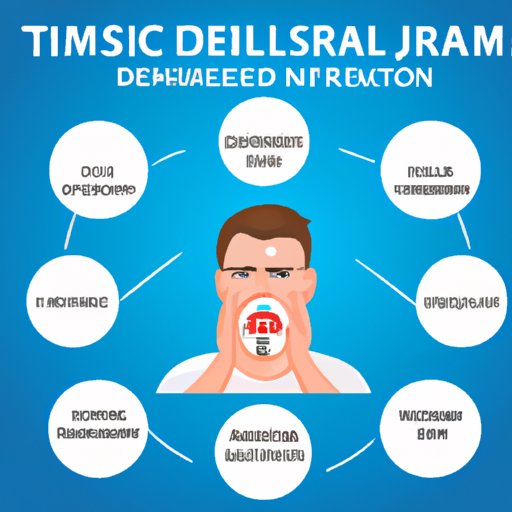
Introduction
If you’ve ever experienced jaw pain, you know it can be incredibly uncomfortable. Jaw pain may point to a disorder of the temporomandibular joint (TMJ), which connects your jawbone to your skull. This joint is complex and helps you perform functions such as speaking and chewing. Understanding the symptoms of TMJ disorder is the first step in identifying and treating the condition. In this article, we’ll define TMJ disorder and dive into its symptoms, causes, and ways to manage the condition.
“Is Your Jaw Hurting? Recognizing the Most Common TMJ Symptoms”
TMJ disorder is an umbrella term for a group of conditions that affect the temporomandibular joint and associated muscles. It often causes pain and discomfort along with other symptoms. Here are some common symptoms of TMJ disorder:
Jaw pain or tenderness
Most people with TMJ disorder experience pain in the jaw joint or the muscles around it. This pain may feel dull or sharp and may be worse when you chew, talk, or yawn.
Clicking, popping, or grating sounds in the jaw joint
You may hear strange sounds when you move your jaw, like clicking, popping, or grating. These sounds are caused by the displaced disc in the joint when you open or close your mouth.
Difficulty opening or closing the mouth fully
Patients with TMJ disorder may find it challenging to open their mouth fully, as if their jaw is locked. Others may feel like they overstretch when they open their mouth, leading to pain and discomfort.
Facial pain or headaches
TMJ disorder can also cause facial pain or headaches, especially around the temples or forehead. This pain might feel dull or throbbing and may worsen with jaw movements.
Earache or ringing in the ears
The temporomandibular joint is close to the ear canal, causing referred pain to the ear and ringing or buzzing noises in the ear.
“Don’t Ignore These Telltale Signs of TMJ Disorder: A Comprehensive List of Symptoms”
In addition to the common symptoms listed above, TMJ disorder may produce other symptoms, such as:
Neck pain
Neck pain is common in patients with TMJ disorder, particularly during jaw movements.
Shoulder pain
Some people with TMJ disorder may also experience pain and discomfort in their shoulders.
Dizziness or vertigo
Dizziness or vertigo (a feeling of spinning or loss of balance) may occur due to referred pain from the jaw.
Eye pain or sensitivity
Eye pain or sensitivity to light are less common TMJ symptoms but may indicate TMJ-related eye strain.
Tingling or numbness in the fingers
Some patients with TMJ disorder may feel tingling or numbness in their fingers, which can occur due to referred pain from the jaw.
“Understanding the Connection Between Stress and TMJ: Common Symptoms and What to Look Out For”
Stress has been closely linked to TMJ disorder, particularly clenching and grinding the teeth (bruxism). Here are some TMJ symptoms related to stress:
Grinding or clenching of the teeth (bruxism)
Bruxism is a common TMJ-related symptom associated with stress and may lead to tooth decay, enamel wear, headaches, facial muscle pain, and jaw pain.
Muscle fatigue or tension in the jaw and face
Stress can cause the muscles around the jaw and face to tense up, leading to pain and fatigue in these areas.
“Lockjaw, Headaches, and More: Unpacking the Different Symptoms of TMJ Disorder”
While less common than the above symptoms, some people may experience more severe or unusual symptoms of TMJ disorder. Here are a few examples:
Lockjaw (inability to open or close the mouth)
Lockjaw can occur in rare cases when the muscles around the temporomandibular joint spasm, locking the jaw in an open or closed position.
Chronic headaches or migraines
Unfortunately, TMJ disorder can cause chronic headaches or migraines, which often go undiagnosed and untreated.
Tinnitus (ringing in the ears)
In addition to pain and discomfort, TMJ disorder can cause tinnitus (ringing or buzzing noises in the ears) due to the joint’s proximity to the ear canal.
Difficulty chewing or biting
Some patients may find it difficult to chew or even bite down, which can cause pain and fatigue in the jaws and even lead to malnutrition.
Tips for Managing TMJ Symptoms
Not all TMJ symptoms require immediate medical intervention. Here are some tips to manage mild to moderate TMJ symptoms at home:
Applying heat or ice to the jaw
Applying moist heat or ice packs to the jaw can help reduce pain and swelling.
Resting the jaw
Resting the jaw by avoiding chewy, hard, or crunchy foods can help ease symptoms.
Practicing stress-reducing activities
Stress reduction activities, such as meditation, yoga, and deep breathing, can lower tension and help relax the muscles in the jaw.
Avoiding hard or chewy foods
Patients with TMJ disorder should avoid hard or chewy foods that require excessive jaw movements.
Seeking professional dental or medical care
If symptoms persist or worsen, patients should seek professional dental or medical care from their healthcare provider.
Conclusion
TMJ disorder is a common condition that affects many people. Understanding the different symptoms of TMJ disorder can help patients identify the condition and learn how to manage it. If you experience any of the symptoms mentioned in this article, speak to a healthcare professional to determine the best treatment for you.
Resources
– American Dental Association (ADA): https://www.ada.org/en/member-center/oral-health-topics/tmj-disorders
– National Institute of Dental and Craniofacial Research (NIDCR): https://www.nidcr.nih.gov/oralhealth/Topics/TMJ/TMJDisorders.htm
– Mayo Clinic: https://www.mayoclinic.





